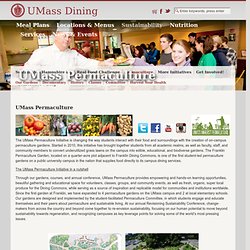

The man who grew his own Amazon rainforest - BBC World Service. Protection of Resources and the Achievement of a Sustainable Society. The Christensen Fund. How farmers can help fight climate change. The other week, I spent some time interviewing several business leaders for the North Carolina Sustainability CEnter, asking them about their reactions to President Obama's climate speach.

Their responses were decidedly mixed, but one discussion stayed with me. When I asked Charles Sydnor, the owner of Braeburn Farm, about the urgency of climate policy for his industry—he had this to say: "As a farmer, when we look at climate change there are two sides to the story – but we only really talk about one – namely the production of greenhouse gases. Yet agriculture should be part of the solution. I can take you to places right now where crops are grown year-after-year-after-year without tilling the land, and where there is increased carbon sequestration year-after-year. Sydnor has a powerful point. No-till farming NRCS Soil Health/CC BY 2.0 Soil has the potential to store huge amounts of carbon.
Producing renewable energy Spearheading conservation jyri/CC BY 2.0 Innovating new ways of growing. Ecologists Turn To Planned Grazing To Revive Grassland Soil : The Salt. Hide captionFox Ranch, outside Yuma County, Colo., is a 14,000-acre nature preserve and working commercial cattle ranch.

The ranch is used by the Nature Conservancy to put into practice its panned grazing technique. Luke Runyon/Harvest Public Media Fox Ranch, outside Yuma County, Colo., is a 14,000-acre nature preserve and working commercial cattle ranch. The ranch is used by the Nature Conservancy to put into practice its panned grazing technique. The world's soil is in trouble. In eastern Colorado, one way could be in the plodding hooves of cattle. Conventional wisdom tells you that if ranchland ground has less grass, the problem is too many cows. "Plants actually respond to grazing. Hide captionEcologist William Burnidge checks a map of Fox Ranch that details the different areas rancher Nathan Andrews can graze his cattle.
Ecologist William Burnidge checks a map of Fox Ranch that details the different areas rancher Nathan Andrews can graze his cattle. Biocultural Heritage. Open Source Seed Initiative. = an organization committed to facilitating vigorous innovation in plant breeding by preserving the right to unencumbered use of shared seeds and their progeny in breeding programs.

"Corporate appropriation of plant genetic resources, development of transgenic crops, and the global imposition of intellectual property rights are now widely recognized as serious constraints on the free exchange of seeds and the development of new cultivars by public breeders and small seed companies. In response, legal and operational mechanisms drawn from the open source software movement have been proposed for deployment in plant breeding. In the United States, an Open Source Seed Initiative (OSSI) has been organized by a working group of plant breeders, farmers, non-governmental organizations and sustainable food system advocates. OSSI promotes innovative plant breeding that produces resilient and productive cultivars adapted to a multiplicity of sustainable agroecosystems. J. Mushroom Cultivation Research and Education. Www.centerforfoodsafety.org/wp-content/uploads/2013/02/Seed-Giants_final.pdf.
Kokopelli. Living democracy, feeding hope. Biodynamic Farming and Gardening Association. Seed Savers Exchange. Inicio. Society of Ethnobiology. AgriCultures Network. University of Massachusetts, Amherst. The UMass Permaculture Initiative is changing the way students interact with their food and surroundings with the creation of on-campus permaculture gardens.

Started in 2010, this initiative has brought together students from all academic realms, as well as faculty, staff, and community members to convert underutilized grass lawns on the campus into edible, educational, and biodiverse gardens. The Franklin Permaculture Garden, located on a quarter-acre plot adjacent to Franklin Dining Commons, is one of the first student-led permaculture gardens on a public university campus in the nation that supplies food directly to its campus dining services.
The UMass Permaculture Initiative in a nutshell What is permaculture? In short, permaculture is a merger of the words "permanent" and "agriculture" and a vision for creating a more sustainable world. Watch our documentary series UMass Permaculture at a Glance.